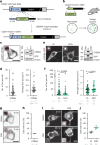Mis-splicing of a neuronal microexon promotes CPEB4 aggregation in ASD
- PMID: 39633052
- PMCID: PMC11711090
- DOI: 10.1038/s41586-024-08289-w
Mis-splicing of a neuronal microexon promotes CPEB4 aggregation in ASD
Abstract
The inclusion of microexons by alternative splicing occurs frequently in neuronal proteins. The roles of these sequences are largely unknown, and changes in their degree of inclusion are associated with neurodevelopmental disorders1. We have previously shown that decreased inclusion of a 24-nucleotide neuron-specific microexon in CPEB4, a RNA-binding protein that regulates translation through cytoplasmic changes in poly(A) tail length, is linked to idiopathic autism spectrum disorder (ASD)2. Why this microexon is required and how small changes in its degree of inclusion have a dominant-negative effect on the expression of ASD-linked genes is unclear. Here we show that neuronal CPEB4 forms condensates that dissolve after depolarization, a transition associated with a switch from translational repression to activation. Heterotypic interactions between the microexon and a cluster of histidine residues prevent the irreversible aggregation of CPEB4 by competing with homotypic interactions between histidine clusters. We conclude that the microexon is required in neuronal CPEB4 to preserve the reversible regulation of CPEB4-mediated gene expression in response to neuronal stimulation.
© 2024. The Author(s).
Conflict of interest statement
Competing interests: K.L.-L. holds stock options in and is a consultant for Peptone. X.S. is a scientific founder and advisor of Nuage Therapeutics. All other authors declare no competing interests.
Figures












References
-
- Gonatopoulos-Pournatzis, T. & Blencowe, B. J. Microexons: at the nexus of nervous system development, behaviour and autism spectrum disorder. Curr. Opin. Genet. Dev.65, 22–33 (2020). - PubMed
-
- Ule, J. & Blencowe, B. J. Alternative splicing regulatory networks: functions, mechanisms, and evolution. Mol. Cell76, 329–345 (2019). - PubMed
-
- Gonatopoulos-Pournatzis, T. et al. Autism-misregulated eIF4G microexons control synaptic translation and higher order cognitive functions. Mol. Cell77, 1176–1192.e16 (2020). - PubMed
MeSH terms
Substances
LinkOut - more resources
Full Text Sources
Molecular Biology Databases

